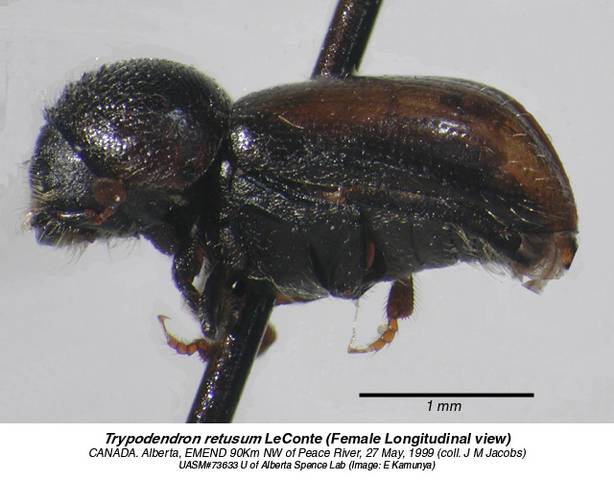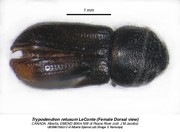Species Details
Trypodendron retusum
University of Alberta E.H. Strickland Entomological Museum Read more about this collection »
SeasonalityInitial flight in spring (early April) till early May, then June to late summer.
IdentificationAdults are distinguished by their large size, smooth and shining surface of elytra with apical margin appearing subacuminate when viewed from above. Colour is uniformly black when mature but young adults have a pale yellowish brown colouration at the base of the pronotum to the apex of elytra. Length is 3.8 – 4.6 mm for females and 3.6 – 4.3 mm for males. Frons are convex with surface reticulated with sparse granules in females. In males they are concave with lateral margins ornamented by abundant hair. In females the anterior margin of pronotum is usually rounded, armed with four teeth, the median pair being larger while in males the margin is feebly recurved and unarmed (without teeth) (Bright, 1976; Wood, 1982).
Scientific Name
Trypodendron retusum
Seasonality
Initial flight in spring (early April) till early May, then June to late summer.
Identification
Adults are distinguished by their large size, smooth and shining surface of elytra with apical margin appearing subacuminate when viewed from above. Colour is uniformly black when mature but young adults have a pale…
Adults are distinguished by their large size, smooth and shining surface of elytra with apical margin appearing subacuminate when viewed from above. Colour is uniformly black when mature but young adults have a pale yellowish brown colouration at the base of the pronotum to the apex of elytra. Length is 3.8 – 4.6 mm for females and 3.6 – 4.3 mm for males. Frons are convex with surface reticulated with sparse granules in females. In males they are concave with lateral margins ornamented by abundant hair. In females the anterior margin of pronotum is usually rounded, armed with four teeth, the median pair being larger while in males the margin is feebly recurved and unarmed (without teeth) (Bright, 1976; Wood, 1982).
Life History
Over wintered beetles appear and become active in early spring from May until early April. They are attracted to suppressed, dying, withdrawn or dead Aspen cut in the previous season, primarily Populus gradidentata…
Over wintered beetles appear and become active in early spring from May until early April. They are attracted to suppressed, dying, withdrawn or dead Aspen cut in the previous season, primarily Populus gradidentata and P. tremuloides. It is the female beetle that initiates tunneling. Boring into the sap wood is fast and completed in a day or two and mating takes place at the tunnel entrance. The male then joins in after mating and assists in removing the accumulated boring dust and frass out of the entrance hole. The female inoculates the tunnels with ambrosia fungus from her mycongia (fungal transmitting gland), (Abrahamson et al, 1967) and boring continues with construction of secondary lateral tunnels. Cradles are then constructed vertically along the lateral tunnels and a single egg is oviposited on each cradle surrounded by the boring material and some fungal cells. Several pairs of beetles use the same gallery with each pair occupying its own branch (Bright, 1976) but one pair for each gallery has also been reported (Brewer et al; 1988). The larvae hatches within a week after the eggs are laid and begin to enlarge the larval cradles until they are slightly bigger than the size of an adult beetle. After two larval instars pupation occurs after three to four weeks and the pupal stage lasts for a month after which the adults emerge. Emerging adults are light brown but colour darkens with age. New adults emerge form brood galleries from mid June to early July. In late summer or early fall, the new adults leave the host trees to over winter in forest litter (Leach et al, 1940; Bright, 1976; Brewer et al; 1988).
Diet Info
Populus spp and Picea spp (Bright, 1976). The larvae gnaw and ingest wood fragments along with ambrosia fungus but only the fungus is completely digested while the wood fragments remain unchanged after egestion…
Populus spp and Picea spp (Bright, 1976). The larvae gnaw and ingest wood fragments along with ambrosia fungus but only the fungus is completely digested while the wood fragments remain unchanged after egestion (Brewer et al; 1988).
Range
From Alaska to New Brunswick south to California, New Mexico, and West Virginia (Wood, 1982).
References
Author
Brewer, D. S., A. R. Beck and A. R. Roeper
Title
Observation of the gallery habits of Trypodendron retusum (Coleoptera: Scolytidae) infesting Aspen in Central Michiga.
Publication Date
1988
Series Title
The Great Lakes Entomologist
Volume
21
Pages
5-8
Author
Leach, J. G., A. S. Hodson, J. P. Chilton, and C. Christenensen
Title
Observations on two ambrosia beetles and their associated fungi.
Publication Date
1940
Series Title
Phytopathology
Volume
30
Pages
227-231
Author
Abrahamson, L. P., Chu, and D. M. Norris
Title
Symbiotic relationships between microbes and ambrosia beetles. II. The organs of microbial transport and penetration in Trypodendron betulae and T. retusum (Coleoptera: Scolytidae).
Publication Date
1976
Series Title
Annals of the Entomological Society of America
Volume
60
Pages
1107-1110
Author
Wood, S. L.
Title
The Bark and Ambrosia Beeltes of North and Central America (Coleoptera: Scolytidae): A Taxonomic Monograph
Publication Date
1982
Series Title
Great Basin Naturalist Memoirs
Volume
6
Pages
150-203
Author
Bright, D. E.
Title
The bark beetles of Canada and Alaska. Coleoptera: Scolytidae.
Publication Date
1976
Specimen Information
There are 11 specimens of this Species.
UASM32957 - Trypodendron retusum
University of Alberta E.H. Strickland Entomological Museum
Place CollectedCanada: Alberta, Peace River
Collected ByJacobs, J. M.
Date Collected1999-05-06/1999-05-27
UASM73606 - Trypodendron retusum
University of Alberta E.H. Strickland Entomological Museum
Place CollectedCanada: Alberta, Edmonton
Collected ByCarr, F. S.
Date Collected1926-05-04
UASM73607 - Trypodendron retusum
University of Alberta E.H. Strickland Entomological Museum
Place CollectedCanada: Alberta, Cypress Hills Provincial Park
Collected ByCarr, F. S.
Date Collected1926-07-01
UASM73608 - Trypodendron retusum
University of Alberta E.H. Strickland Entomological Museum
Place CollectedCanada: Alberta, Edmonton
Collected ByCarr, F. S.
Date Collected1911-05-06
UASM73609 - Trypodendron retusum
University of Alberta E.H. Strickland Entomological Museum
Place CollectedCanada: Alberta, Edmonton
Collected ByCarr, F. S.
Date Collected1911-05-10
UASM73610 - Trypodendron retusum
University of Alberta E.H. Strickland Entomological Museum
Place CollectedCanada: Alberta, Wabamun
Date Collected1917-08-17
UASM73611 - Trypodendron retusum
University of Alberta E.H. Strickland Entomological Museum
Place CollectedCanada: Alberta, Edmonton
Collected ByCarr, F. S.
Date Collected1915-04-14
UASM73631 - Trypodendron retusum
University of Alberta E.H. Strickland Entomological Museum
Place CollectedCanada: Alberta, Peace River
Collected ByJacobs, J. M.
Date Collected1999-05-27
UASM73632 - Trypodendron retusum
University of Alberta E.H. Strickland Entomological Museum
Place CollectedCanada: Alberta, Peace River
Collected ByJacobs, J. M.
Date Collected1999-05-27
UASM73633 - Trypodendron retusum
University of Alberta E.H. Strickland Entomological Museum
Place CollectedCanada: Alberta, Peace River
Collected ByJacobs, J. M.
Date Collected1999-05-27
UASM73634 - Trypodendron retusum
University of Alberta E.H. Strickland Entomological Museum
Place CollectedCanada: Alberta, Peace River
Collected ByJacobs, J. M.
Date Collected2000-05-13



